Case study description Brazil – Mato Grosso.
The following is a short description of policy and research questions in the Mato Grosso case study of POLICYMIX. This page will be continually updated as the case study focus is developed. Assessments of economic instruments in their policymix in case studies will take place in 2011-2013.
Contact: Peter H. May, REDES or Joao Paulo Soares de Andrade, ICV
1. Introduction
2. National/Federal level case study
3. State and local case study
4. Northwest Region of Mato Grosso
-------------------------------------------------------------------------------
The Mato Grosso case under development will focus on a range of existing instruments and those under development associated with efforts to reduce deforestation in the Amazon biome of the state. Because Mato Grosso is the largest single source of deforestation and related greenhouse gas (GHG) emissions in Brazil, in turn responsible for a significant share of global emissions, the forces that stimulate its frontier expansion are of global concern.
Our analysis of the national context will focus on federal law and regulation associated with conservation of Brazil’s tropical forests and efforts to reduce deforestation, with emphasis on the Amazon basin. Property rights in the region represent a complex mosaic of public and private rights, still in process of regularization. Federal requirements for forest conservation in private lands are currently the object of national debate, whose outcome is not easily predictable.
Conservation status and objectives
Only part of intact Amazon forest remnants, totaling about 3.5 million km2 in Brazil is protected.
According to 2005 estimates, in the Legal Amazon region – which includes forest and non-forest areas totaling 5.5 million km2 in nine states – only about 30% of land is in private properties, while about 37% is protected in public lands, including indigenous and extractivist reserves (see map).
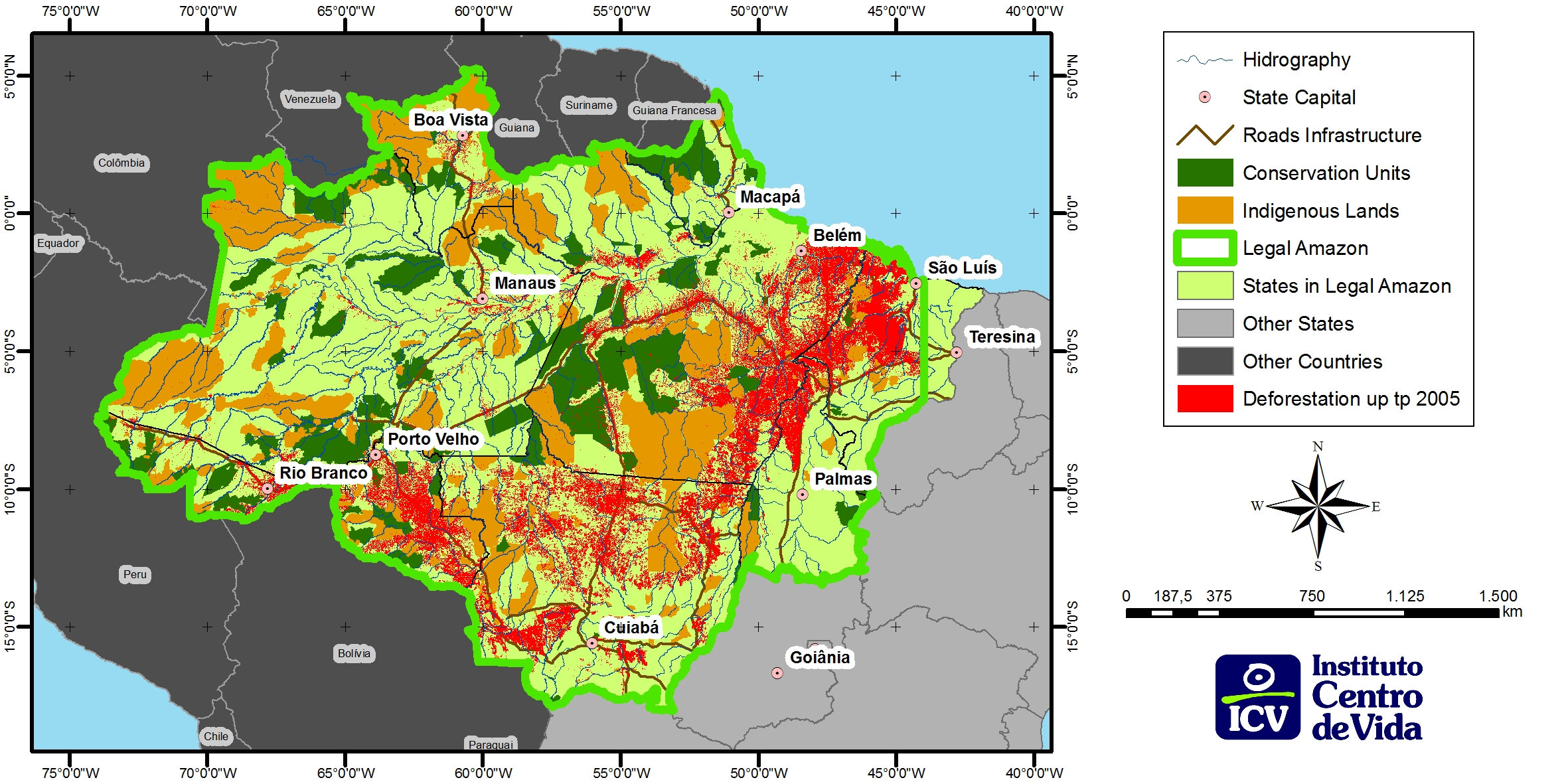
Another one-third of the region is contested, and claims are associated with rural violence and illegality
(Table 1)
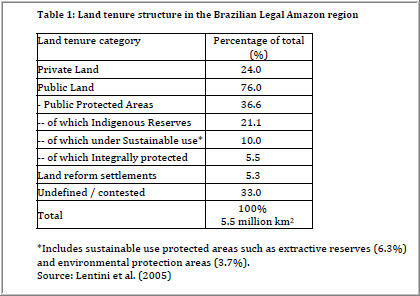
2.1 Main economic instruments in use in forest/biodiversity conservation and related regulatory instruments
Private land use in the Amazon biome is regulated by the national Forest Code, whose strictures require that 80% remain under forest cover in so-called “legal reserves”. Ecological-economic zoning (EEZ) is required at the state level by the federal constitution, to provide indicative basis for allocation of credit and other public incentives. In the presence of EEZ, the legal reserve may be reduced to 50% in areas designated for productive use. Forests, whether within legal reserves or outside them, may be managed for timber and non-timber forest product extraction, subject to a federally approved management plan (recently undergoing decentralization). Fragile lands (steep slopes, hilltops, streambanks) are subject to permanent protection and cannot be used for productive purposes. Private landowners whose properties do not comply with these strictures are required to restore forests up to the required limits, or purchase land elsewhere to achieve compliance. A market for legal reserve “quotas” is foreseen.
On public lands, forests may be the subject of concessions to private enterprises, once lands for conservation and community use are set aside. Environmental goods and services generated by such concessions may be commercialized by the concessionaire, with the exception of carbon credits associated with avoided deforestation (carbon sequestration may be credited).
2.2 Brazil’s deforestation trends and reduction policies
Deforestation trends
Deforestation and forest degradation have occurred since colonization in Brazil, but only since the 1970s has it reached alarming proportions in the Amazon. Deforestation in the Amazon has been largely a product of federally subsidized land settlement and colonization, combined with private cattle ranching (also subsidized until the 1980s) and public infrastructure, particularly road construction. Timber extraction, often illegal, has preceded or accompanied land clearing for agropastoral production, serving as a ready source of capital to finance this process.
Deforestation in the Amazon has been monitored by satellite annually by the federal space research agency INPE1 since the 1980s; more recent monitoring permits real time alert where land use change is in progress.Two major peaks in deforestation occurred in Brazil: in 1995, when it reached 29,000 km2 (about 0.8% of remaining forestland of approx. 3.7 million km2); and during the 2000-2004 period, reaching 21,500 km2, peaking at 27,772 km2 in 2004 (0.78%). Deforestation rates subsequently dropped 59%, declining rapidly from 19,100 km2 in 2005 to around 12 thousand km2 in both 2007 and 2008 (< 0.4%), followed by a substantial decline to an estimated 7,008 km2 (0.2%) in 2009 (INPE 2008, 2009).
The most recent decline is the basis for the government’s claim of significant progress in implementing policies to reduce its major source of greenhouse gases (GHG) emissions – deforestation in the Amazon region, and sustain that it will tend to zero as command and control policies are maintained, fundamental to Brazil’s RED position in the UNFCCC.
Deforestation reduction policies
Prior to discussion in the realm of the UNFCCC , concern for Amazon deforestation was expressed at the 1990 summit of the G-7, and commitments made to combat its driving forces with financial support to national efforts by Brazil.. The ensuing a Pilot Program for the Protection of Brazilian Rainforests (PPG7) was designed and implemented (in 1995), encompassing five main themes: Experimentation and Demonstration, Conservation of Protected Areas, Research Support, Institutional Strengthening and Learning and Dissemination. In 2002, The National System of Conservation Units Law was enacted, and with the PPG7 programs’support, Indigenous Lands, which are recognized as a major vector in biodiversity conservation in Brazil (with protected area status) increased by 38 million ha. Between 1992 to 2004, the overall amount mobilized by the PPG7 totaled U.S. $ 428 million, including the financial contribution of the Brazilian government (MMA, 2005 2)
Outcomes
Despite progress in creation of new conservation units and demarcation of indigenous territories the overall fragile results of the PPG7 program are considered fragile Divergent views exist on the development model for the nation and its rainforests. It is increasingly clear that to achieve further reduction of deforestation rates will be dependent on structural changes in socioeconomic and political motivating factors.
In 2004, based on the PPG7 lessons, the federal government set up and successfully implemented a Plan to prevent and control deforestation. More recently, Brazil established the Amazon Fund (based on the PPG7 lessons) and launched its National Plan for Climate Change (PNMC) with particular attention to land use change and forests. Moreover, Brazil is adopting a voluntary goal to reduce total GHG emissions by 36 to 39% by 2020 compared to a business-as-usual scenario implying an overall stabilization of emissions at the current levels, with drastic cuts in deforestation related emissions. This goal encompasses a target consistent with goals set out in the NPCC to reduce Amazon deforestation rates by 80% by 2020 compared to the 1996-2005 average (Figure 2).
However, contradictory moves still being made, with (a) persistence of rural credit programs that stimulate deforestation, especially for cattle ranching (US$ 3.5 billion invested in cattle ranching in the Brazilian Amazon); (b) large-scale infrastructure projects: The Programa de Aceleração do Crescimento – PAC (Program to Accelerate Economic Growth), bringing "politicization" of environmental licensing procedures and (c) attempts (from the agribusiness lobby) to undermine the Brazilian Forestry Code and other environmental legislation. Meanwhile, the Brazilian government has not yet adopted a clear position on this issue, pitting the Environment Ministry against the influential Agriculture Ministry and agribusiness lobby.
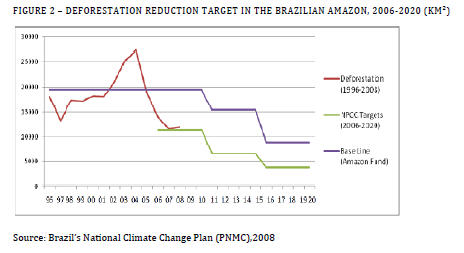
2.3. New instruments under consideration or to be assessed.
The national level case study will concern itself with instruments in place and in process of development to complement the Forest Code, such as payment for environmental services and legal reserve quotas. The national REDD+ program, in process of construction, may include the adoption of such instruments to complement other mechanisms such as tenure regularization, credit restrictions and environmental licensing, as a means to ensure progress toward the goals of the PNMC. For example, the national monetary council recently excluded proprietors who had not regularized their environmental licensing from receiving further rural credit. The national case study will also examine (with reference to the work in WP2) the legal basis and experience to date in environmental fiscal transfers, via the ICMS Ecológico.
3.1.General description of the area
The State of Mato Grosso is located in the heart of the South American continent in the Center-West Region of Brazil.
With a total area of 903 thousand km2, it represents 11% of Brazil’s territory. Its natural habitat is composed of three main biomes: the Amazon forest, the cerrado (savannah) and the Pantanal wetlands.
Mato Grosso is a state of relatively recent frontier occupation. Beginning in the 1970s, numerous colonists arrived from traditional agricultural lands in southern Brazil, a diversified mass of small, medium and large land-owners enticed by a package of government incentives and investments.
Its population now totals 2.85 million people, with an urbanization rate of 76%.
During the last decades Mato Grosso became Brazil’s largest producer of grains and livestock.
Soybean production has grown at an average rate of 10% per year since 1990 and reached 17
million tons in 2008 (29% of Brazil’s production and approximately 8% of the world’s total
production). During the same period, cotton production increased from less than 0.1 to more
than 2 million tons (52% of Brazil’s production). Cattle herds grew by 8% annually from 1990 to
2004 and have stabilized at 26 million head – by far the Amazon’s largest herd – since then. Mato
Grosso is also the largest producer and processor of timber in the Amazon, with an average
annual production of 3.6 million cubic meters of logs processed in the last four years, although
this production is declining as remaining stocks are exhausted..
Most of Mato Grosso’s agricultural production is directed to exports. As for soybean, European
countries represent 54% of Mato Grosso’s exports, Asian countries 44% and other countries 2%.
As for beef, Europe is also Mato Grosso’s main buyer with 33% of the total, while the Middle East
represent 31%, Americas 26% and other countries 10%.
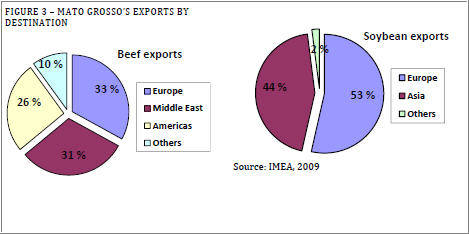
Beside this export-oriented agribusiness sector, Mato Grosso also has a large number of family
farmers, most of whom were settled through public agrarian reform projects. The situation of
the settlements is quite different for large and medium farmers. Despite efforts to improve the
distribution of land, the settlements are mostly excluded from the benefits of the agricultural
growth of the state. More efficient public policies are essential to bring these economic benefits
to the settlements.
As a result of the world’s growing demand for Mato Grosso’s products, the
state has been one of Brazil’s fastest growing economies. Its GDP amounted to R$ 42 billion in
2007, an 11% growth (in real terms) over 2006. Agriculture, forestry and livestock account for
approximately one third of Mato Grosso’s GDP and are considered the main drivers of the state’s
economic growth.
Conservation objectives
Figure 4
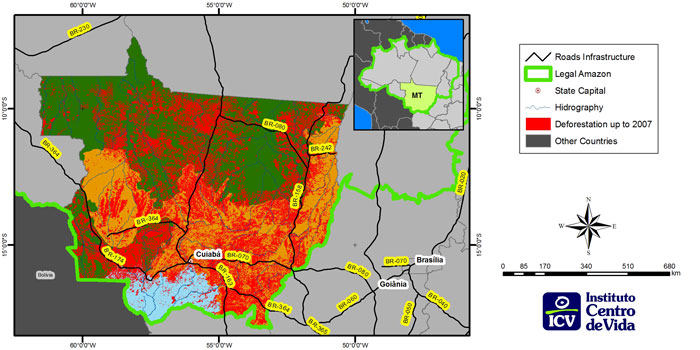
In parallel to the expansion of agriculture and livestock production, despite considerable
productivity gains, large areas of forests and cerrados were converted into pasture and crop
lands during the last decades. Mato Grosso’s agricultural and livestock production currently
occupies 335 thousand km2, which represents 37% of the state’s area (Figure 4). More than 55%
of these areas were deforested after 1990.
The demand for agriculture land is expected to continue increasing strongly in the next decades.
Only about one-third of expected output growth in Brazilian soybean production is expected to
come from yield improvement, while global demand is expected to continue growing strongly in
coming decades (FAO, 2009)
All these factors tend to increase the value of land and the opportunity costs of conserving
standing forests. For example, average land price in Brazil’s Center-West region increased by
47% over the 2007-2010 period, despite the global economic crisis. The average opportunity
cost of not deforesting one hectare of remaining forests in Mato Grosso is estimated to be
approximately U$1,500.3 It will take strong efforts and investments in productivity enhancement
to maintain the growth trend of agricultural and livestock production in Mato Grosso without
further deforestation.4
In addition to deforestation, forest degradation is a growing concern in the Brazilian Amazon
and especially in Mato Grosso. In recent years, deforestation rates have declined but forest
degradation rates have not. This might be related to the growth of forestry activities with still
poor forest management practices.
3.2 Main ecosystem services under evaluation
The importance of Mato Grosso’s forest ecosystems for provision of global, regional and local
environmental services varies with the scale of analysis. At a continental scale, the region is
important for the production and transport of humidity to the southeast of Brazil and
neighboring countries, essential for productive agriculture there (the “flying rivers” hypothesis;
(TEEB , 2010)). While this hypothesis may be valid, its valuation is well beyond the scope of this
project. The state is also strategically located within the Amazon and Paraguay basins,
containing some of the principal headwaters that provide water for hydroelectricity and
transport to downstream areas, estimated to provide as much as 20% of all water sources in
Brazil. Valuation however will focus on more localized biodiversity and carbon stocks rather
than regional or continental hydrological flows.
The region is particularly important as a transition zone between different biomes, from the
cerrado to dense Amazon rainforest, creating a phytogeographic mosaic of great complexity and
value both in preservation and in use. Its use values in the intact state are particularly prized by
indigenous and traditional communities, whose knowledge of remaining biodiversity is
threatened both by acculturation and deforestation. However, there are also important market
values associated with both current and potential use of forest resources whose development
depends on investments in social capital, local enterprise and national/international market
penetration. Opportunity costs are associated with timber extraction and forestland conversion,
to a combination of smallholder shifting agriculture and ranching, although there are
considerable potentials for agroforestry and low impact agroextractive systems, which may be
compatible with REDD+.
3.3. Main actors/ stakeholders
Mato Grosso has 15% of its area protected in 68 Indigenous Areas and 4% protected in 73
Conservation Units.5 It also has 386 smallholder settlements covering 5% of its territory.6
The remaining area, which corresponds to 77% of the state’s territory, is mostly occupied by
medium and large private properties. Approximately 30% of this area is already registered in
the SIMLAM system, Mato Grosso’s environmental registry for rural properties
(Table 2, Figure 5).

Figure 5: Land tenure structure in Mato grosso
Besides direct land users, other stakeholders include equipment and input vendors, transport
providers and processing industries, such as slaughterhouses and food processing. Commercial
agents also play an important role in rural settlements. Policymakers and government agencies
are also key stakeholders in the direction of incentives and instruments adopted.
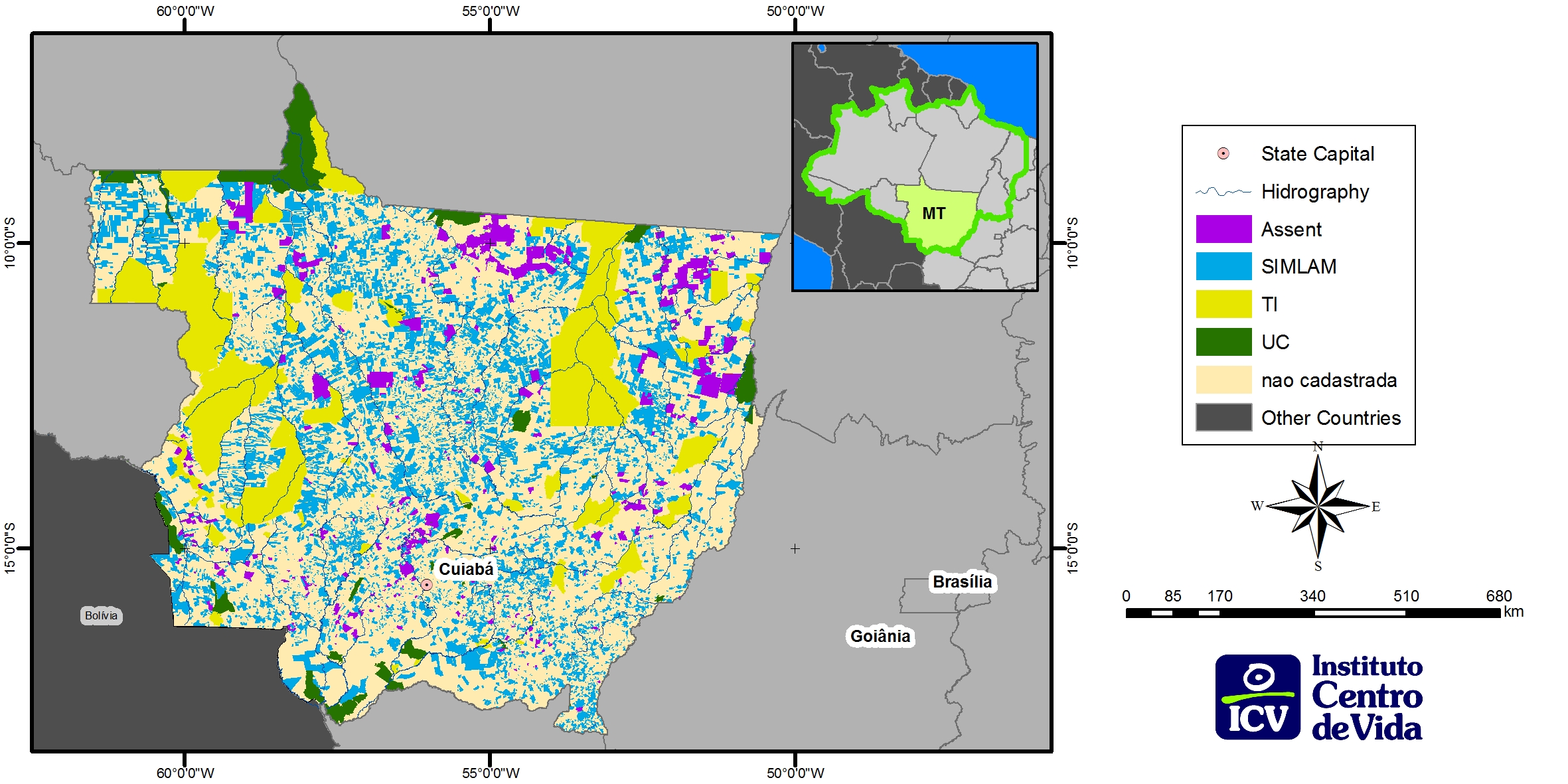
3.4 Main economic instruments in use in forest/biodiversity conservation and related
regulatory instruments
Matogrosso's ecological economic zoning (ZSEE)
Zoning has been required since 1990 by the Federal government in the nine states that compose
the Legal Amazon. State Ecological-Economic Zoning(ZSEE) is an instrument of territorial
planning with the objective of influencing decisions of public and private actors regarding the
use of natural resources, and balancing maintenance of natural capital and ecosystem services
with economic activities. The spatial distribution of economic activities under ZSEE takes into
account the limitations and fragilities of ecosystems, establishing restrictions and alternatives to
territorial expansion of their exploitation.
In Mato Grosso, the ZSEE document was presented by the executive to the legislature in the first
half of 2008, designating several restrictive uses and new protected areas, giving vent to a series
of 16 regional public hearings. A sizeable social mobilization occurred, marked by heated
debates that expressed diverse political and ideological positions. This mobilization was an
exercise of popular participation marked by a test of forces between social and environmental
movements – usually the minority in these hearings – and those mobilized by agribusiness
interests.
In the final stage of public consultation, the State Assembly worked behind closed doors with a
technical commission responsible for devising the proposed bill for State zoning for the second
half of 2009. The greatest challenge now is to make this process, marked by ample debate among
civil society participants, a valued reference for this final stage. The greatest concern is that
sectors such as agri-business that hold greater representation in the Assembly will look out for
their own interests over other sectors’ positions presented and debated in the public
consultations. The role of socio-environmental institutions is fundamental to bringing society
documented information regarding the relevance of implementing the ZSEE.
Mato Grosso's deforestation reduction policy
With the decentralization of forest governance, the Amazon states have played an increasing
role in the country’s efforts to reduce deforestation. Especially, Mato Grosso, which accounted
for 39% of the total deforestation in the Brazilian Amazon region during 1996-2005, with an
average of 7.7 thousand km2 per year, has taken bold actions to improve forest governance and
curb deforestation. For example, it has implemented a pioneering environmental licensing
system for rural properties, which allows for a better control over deforestation. In nine years of
implementation, 23% of the state area located in private areas (see table 2 above) are monitored
by this SIMLAM system . Since 2006, it more than doubled the staff of its environmental agency
and strongly increased field enforcement operations. In parallel to this, deforestation has
decreased to an annual rate of 2.8 thousand km2 during 2006-2009, a 63% reduction. Mato
Grosso contributed with some 59% of the deforestation reduction that took place in the
Brazilian Amazon over the past four years.
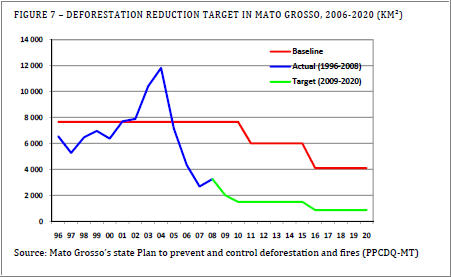
In order to sustain further reduction in deforestation, Mato Grosso launched in November 2009 its own Plan to prevent and control deforestation and fires and adopted a target to reduce
deforestation rates by 89% by 2020 compared to 1996-2005 (Figure 7).
This target represents more than 60% of the national target for deforestation reduction in the Amazon, and
approximately 40% of Brazil’s total goal of GHG emission reduction by 2020.
These figures demonstrate the expressive scale of Mato Grosso state’s challenge within the
context of Brazil’s international commitments to reduce GHG emissions.
Mato Grosso's deforestation reduction plan
Mato Grosso’s action plan to prevent and control deforestation and fires is composed of an
integrated set of programs organized in three areas:
• Land use planning: sanction and implement the state zoning plan; legalize rural
properties’ land tenure and compliance with environmental laws; and consolidate the
system of state conservation units, implementing the existing reserves and creating new
ones, according to the state zoning;
• Monitoring and control: monitor and report on forest governance through indicators;
prevent forest fires and tackle illegal burning practices; and strengthen law enforcement
through field operations and improved judicial efficiency;
• Incentive to sustainable activities and economic instruments: implement Payment for
Environmental Services; define sustainable criteria for financing agriculture and
agroindustry; strengthen training and technical assistance and promote productivity
increases, best practices and certification in the agriculture and forestry sectors; and
induce sustainable development in rural smallholder settlements.
Among these actions, one of the most important is the “Legal Mato Grosso” (MT Legal) Program,
also officially launched in November 2009. This program will promote the regularization of land
tenure and environmental compliance of rural properties in the state, through the registry of
rural properties into the state environmental licensing system. The MT Legal aims to accelerate
through tax incentives the registration of private properties in SIMLAM. With the MT Legal
program, it is expected from the government that most of the state’s properties will be
registered in the next three years.
The “Ecological Value Added Tax” (ICMS Ecológico or ICMS-E, according to May et al., 2004), as
implemented in Mato Grosso, adheres to the same legal underpinning of the instrument as
adopted in other states of the federation, namely the national constitution: 25% of the portion of
state value added taxes due to municipalities may be allocated according to formula at the state’s
discretion. This discretionary clause allows states, including Mato Grosso, to allocate a
proportionally small but significant share of the proceeds from such taxes (which are levied at
17% of all goods and services transactions internally and 12% on interstate transactions), to
those municipalities which have allotted part of their land area to conservation units. The
allocations are based on formulae which vary between the states. In Mato Grosso, different from
other states, indigenous areas are included in the calculation, which for some municipalities
cover a substantial proportion of their area.
Currently, of 141 municipalities existent in Mato Grosso, 86 are benefitted with revenue
increments from this source. For the principal beneficiaries, the increased amount varies
between 10% and 60% of their prior allocation. The majority of municipalities receive only a
fraction of this.
The value currently transferred is based on the simple result of the sum of protected areas and
indigenous territories, multiplied by their respective weighting factors by category of protection
and divided by each municipality’s area. However, the instrument is currently being refined to
qualify the return to municipalities to benefit the ones that have superior performance of quality
indicators, considering protected areas’ status and socio-ecological performance. The value of
the quality-based transfer is expected to increase or decrease the amount of ICMS-E up to 5%.
An evaluation system will allow this percentage increase or decrease, encouraging
municipalities to improve efforts on the quality of their protected areas and resident indigenous
peoples.
3.5 New instruments under consideration or to be assessed
PROPOSED REDD MECHANISM
In the context of the international climate change regime, today it seems possible to mobilize
resources and adopt instruments able to guarantee a strong and sustainable reduction in
Amazon deforestation. This can be done through the implementation of a program for the
Reduction in Emissions from Deforestation and Forest Degradation (REDD). The
implementation of REDD can be employ a combination of command and control instruments and
economic instruments.
At the same time, the State offers important preconditions for the implementation of the REDD
mechanism: appropriate instruments for the environmental licensing of rural properties, its own
institutional structure for regulation of forest management, a relatively well established land
tenure situation, and wide support from Government, civil organizations and economic sectors.
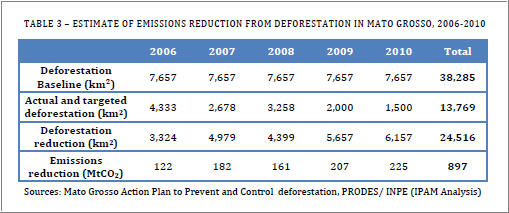
Considering a minimum price of US$ 5.00 / tCO2e, the total amount potentially available for this
program is estimated at US$ 1.1 billion, to be invested during 2011-2015.
REDD funds are considered a unique opportunity and a necessity to achieve the plan’s ambitious
targets. There is now a widespread awareness about the opportunities linked to a REDD
mechanism, and the relevant stakeholders including the government, the agriculture and
forestry sectors, many indigenous communities and part of the family farming sector, along with
the environmental NGOs, are defending the implementation of REDD at the state level as a key
strategy to achieve lasting deforestation reduction without sacrificing the state’s economy.
As a result, several REDD pilot projects of different types are under preparation. In parallel to
this, the state is trying to develop a basic REDD framework as part of the California-led
Governor’s Climate and Forests (GCF) task force, expecting to be able to issue REDD credits in
the coming years. And state-wide public policies for different sectors (such as a compensation
scheme for landowners who maintain forests in excess of the 80% “legal reserve” requirement)
are starting to be discussed.
However, these efforts lack coordination – with the strategies proposed in the state plan to
control deforestation, between projects and state-level initiatives, as well as with other states in
the region and with the process at the federal level. In this context, it is essential to structure
rapidly the state REDD system, including an adequate regulatory, institutional and technical
framework, and to develop state-wide policies for the different economic sectors/ stakeholder
groups involved based on the strategies developed at the local, project level.
Developing the REDD system consists in establishing the regulatory, technical and institutional
framework for the REDD activities in the State: developing the REDD law and regulations, as part
of the state Climate Change policy; establishing principles, criteria and procedures for the
registration and/ or certification of REDD projects and state-wide, sector-specific programs;
defining the state baseline, carbon accounting and insurance systems, in agreement with the
requirements of future regulated carbon offset markets; designing the instrument to serve as
future REDD credits to be issued by the state; and defining the functions to be carried out to
manage this REDD system and the roles to be performed by the different institutions that will
take part in it and the governance mechanisms for these institutions.
Developing the REDD programs consists in designing the specific actions to be implemented in
state-wide, sector-specific programs in order to reach the deforestation reduction target. Such
programs should include: i) a compensation scheme for private landowners who conserve
forests in excess of the 80% legal requirement (Private Forests Program); incentive mechanisms
for increasing productivity of agriculture and cattle ranching (Agriculture & Livestock Program);
a compensation and sustainable development scheme for Indigenous Peoples (Indigenous
Peoples Program); a sustainability package for smallholder settlement farmers (Family Farming
Program); a program to increase and effectively implement the state protected areas (Protected
Areas Program), among others. The development of these programs should be based on the
experiences of the pilot projects – however some of them, such as the Private Forests Program,
might start earlier since its basic instrument (the environmental licensing system of rural
properties) is already in place.
The implementation of Mato Grosso’s REDD mechanism will be managed by the State Climate
Change Forum, established in October, 2009, which is composed of representatives of the State
Government and Civil Society organizations and the different stakeholder groups involved.
In March, 2010 the REDD working group in the State Forum on Climate Change was created. This
Forum is the legally established participatory group that will develop the state policy on climate
change, and has the participation of over 40 institutions representing all the relevant
stakeholder groups. The REDD working group is responsible for preparing proposals on the
REDD theme, considered the main challenge and opportunity in terms of Climate Change policy
in Mato Grosso. This working group has more than 20 participants, including representatives of
most of the institutions in the Forum, but also from various experts from different government,
non-government and private-sector institutions, with different backgrounds, geographically and
thematically.
The working group’s first priority is to develop a REDD law proposal, which should be concluded
by the end of November 2010. The next steps will include developing the law’s regulations (once
the law is passed by the State Assembly) and to design the REDD programs mentioned above. In
parallel, the group will produce a new, revised version of the State REDD Plan document, which
will be used within the context of GCF and for fund raising.
The northwest region of Mato Grosso is located in what is called the Amazon Arc of Fire, a region
characterized as a tropical forest frontier and
equivalent in area to the entire country of Panama
(10,762,290 ha).
The regioncontains a complex
and dynamic socio-economic system as well as an extensive area of native forests covering 8,616,970 ha.
Indigenous Indigenous territories cover 38,600 km2 and are home to six indigenous peoples
belonging to three different language groups. Four “uncontacted” isolated indigenous peoples are also
located in the region. In this sparsely populated area (1.4 inhabitants/km2) approximately 38% live in rural areas, with 11 agrarian reform settlements covering 3% of its area 7.
The presence of the State is limited, and, as a result, major land conflicts are known to occur.
The region is composed of seven municipalities: Aripuanã, Castanheira, Colniza, Cotriguaçu, Juína, Juruena,
and Rondolândia. This is the most active land-use frontier in the world, accounting for nearly
half of all tropical forest loss during 2000-2005, but more than 80% of forest cover (86 thousand
km2 of its original 104 thousand km2 of forest still remain. Approximately 31% of its forested
land is protected in 11 indigenous areas and 4% protected in 9 reserves. The remaining area,
which corresponds to 62% of the region’s original forested land, is mostly occupied by mediumlarge
private properties.
Site description
Forestry and cattle ranching are the major economic activities, and the ones leading to
deforestation. Agriculture is less expressive and mainly directed to subsistence activities or to
the local market. Population migration in recent years from other regions in Mato Grosso and
from neighboring Rondônia State and subsequent pressure for settlement areas, together with
land speculation and illegal occupation of land, are other drivers of deforestation and
degradation. Similarly to other frontier areas, in the Northwest region intensive legal and illegal
forestry exploitation without adequate techniques leads to forest degradation, which is
subsequently followed by fires, clearance and conversion to pastures.
In recent years cattle ranching activities have expanded rapidly in Mato Grosso State with a 30%
growth in cattle herd between 2000 and 2007. This expansion also reached the Northwest
region, which in 2007 had more than 2.1 million head of cattle, more than twice as much as in
2000. Juina is already ranked high on the list of municipalities with the largest cattle herd in
Brazil. This growth is expected to continue due to the substitution of pasture by intensive
agriculture in other regions of the State.
Cattle ranching in Mato Grosso is performed in different land holding sizes. Small landowners
concentrate on calf production, whereas large landholders focus on suckled calves and range
fattening. Meat is processed either in Juína or is sent to neighboring cities. Two new
slaughterhouses are under construction and, once active, are expected to triple meat processing
in the region. Most of the meat produced in the Northwest is exported to other Brazilian states
or to other countries. Land use surveys in Juína and Cotriguaçú revealed a current gross income
of U$ 100.ha.year-1 for cattle ranching, that attains U$ 300 where the cattle raised is for mixed
purposes (meat and dairy).
Timber exploitation is centered in the municipalities of Colniza, Aripuanã and Cotriguaçu, but
timber extraction in the region decreased in 2005 following a large command-and-control
operation, and the area under sustainable forest management has increased since then (Figure
9). Timber extraction fraud is still frequent though: timber stocks tend to be overestimated in
forest management plans and the exceeding timber is supplied by pirate loggers who extract
high value wood from public and private areas or indigenous lands.
A study done by Imazon (Monteiro et al, 2008) assessed illegal logging in the Northwest region
of Mato Grosso and found that only in 2007 a total of 483 km2 were illegally logged, 86 of which
inside protected areas and indigenous land. It also identified in the region more than 30
thousand km2 with high potential for sustainable forest management and concluded that the
region has the potential to supply the local timber industry if a well-implemented policy can be
adopted to assure that those areas will be managed sustainably. However, the success of this
policy will require incentives to increase the engagement of landowners on Improved Forest
Management practices, as well as the commitment of the forestry industry to buy only products
from areas that are being managed and are certified.
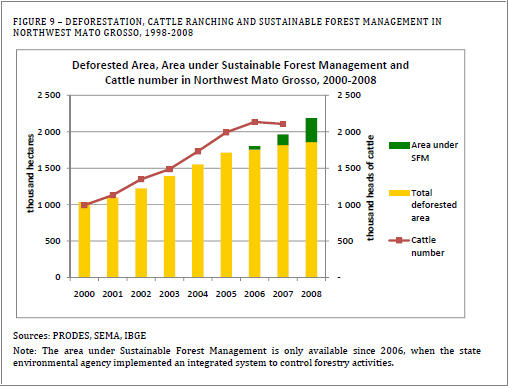
2001-2010: the GEF/UNDP/SEMA project
Financed by the Global Environment Fund (GEF) for the period between 2001 and 2010, the
venture is being implemented by the United Nations Program for Development (UNDP) and the
Mato Grosso State Government through its Department of Environment (SEMA-MT). It aims to
promote alternative land use systems and territorial environmental management for the
purpose of subsidizing public policies aimed at balancing socio-economic development with
biodiversity conservation. Targets for the the last project cycle (2009-2010) included: (a) $1.78
million to consolidate the activities related to the mosaic of Protected Areas and Ecological
Corridors; (b) $476,000 for promotion and consolidation of sustainable agriculture and
agroforestry activities in private areas; (c) $39,000 for the management of low impact forest
timber production. Also, $2.6 million were raised by twelve additional projects being developed
in six of the region’s seven municipalities over the 2007 to 2011 period. These projects are
coordinated by eleven different local partner organizations including five municipal
governments, two indigenous associations (Zoró, Rikbaktsa), and three associations of private
colonists and agrarian reform settlers.
Besides this large social-ecological network, practical results include parameters and indicators
for refining and consolidating Ecological Economic Zoning at the municipal level. Ongoing
studies are revealing that innovative farmers participating in the project shows less
deforestation per person/ha (11.5% below their municipality’s average); more preserved forest
cover (53% average); fewer cattle per capita (50% average) and greater Gross Domestic Product
per capita (51% average). The project helped to improve data and methods established for the
management of the Meridional Mosaic of Protected Areas of the Amazon; and invested in nontimber
forest production (mostly Brazil nut and rubber latex), helping to manage 760,000 ha of
forest on two Indigenous areas and one agrarian reform settlement (out of eleven). The
demonstrative efforts in farmer’s and indigenous organization helped to attract more than $1.5
million of public investment obtained from Banco do Brazil’s Rural Sustainable Development
Fund through the Intermunicipal Consortium for the Development and Preservation of
Environmental and Socio-economic activities in Juruena’s Valley in Mato Grosso Legal (MTLegal)
Program. Concerning the timber industry, the project helped to consolidate a pioneer
Forest Stewardship Council (FSC) management certificate for Rohden Lignea SA (29,000 ha of
certified forest under management). The overall results and its social network supported the
choice for the region as one of two sites in Brazil to host a REDD Pilot Project, which is described
below.
REDD Pilot Project
Following efforts to assess the opportunities and challenges for implementing REDD in Mato
Grosso (Micol, Andrade, Bonner, 2008) and a feasibility study led by TNC, the Northwest region
of Mato Grosso has been pointed out as a top-priority area for curbing deforestation through a
large-scale, multi-stakeholder REDD experiment. While the REDD pilot represents in itself an
important piece of the State Government’s strategy to reduce deforestation and forest
degradation, it should also serve as a basis for the design of other REDD projects in Mato Grosso
and inform the global negotiations on a future climate change regime.
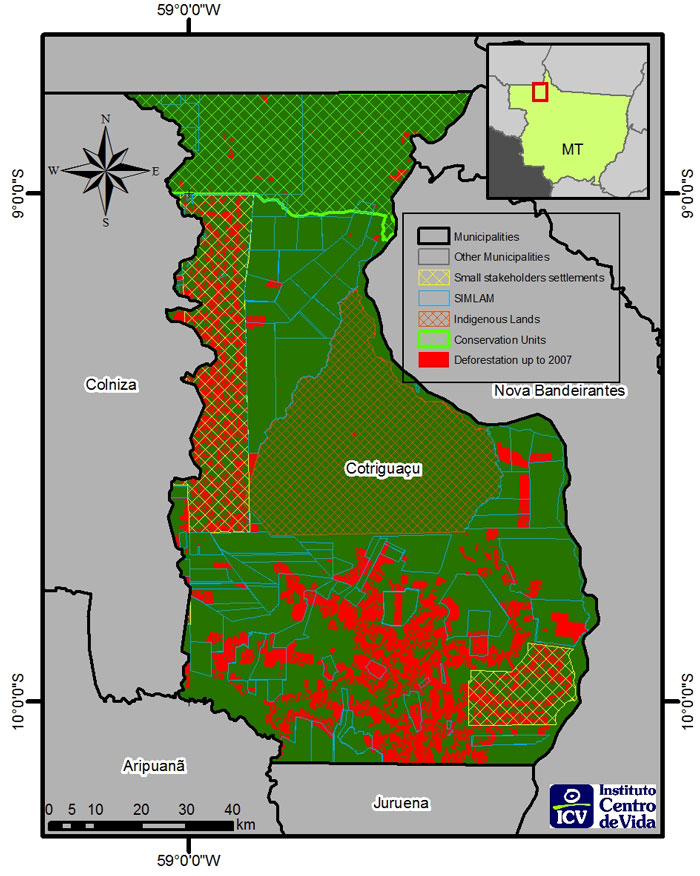 Figure 10
Figure 10In this project outline, the ICV briefly present the project area, institutional design and agenda, at this preliminary stage of the project’s development.
Cotriguaçu
Given the broad extension of the project area and challenges associated to this task, a REDD pilot project will focus during a first phase on a priority municipality, Cotriguaçú, (Figure 10).
Its diversity of land tenure categories (protected areas, indigenous lands, rural settlements and private lands) provides an ideal scenario for a demonstrative REDD project through the implementation of a range of strategies.
At the same time, we will work on preparing the other municipalities for the second phase of the project, mainly by promoting land registry and environmental compliance.
Project strategy
In order to assure a sustainable reduction in deforestation and forest degradation rates, we will adopt a strategy composed of three main components: i) improvement of the governance of forests in the region; ii) incentives for forest conservation in private lands; and iii) guarantee of a compensation for indigenous and other traditional peoples and for local rural communities (small farmers settlements).
- Strengthen forest governance
The improvement of forest governance is widely acknowledged as a fundamental piece of a
REDD strategy. On the one hand, poor governance is appointed as one of the major underlying
causes of tropical deforestation; on the other hand, strong governance is considered key to make
the implementation of economic incentives possible
- Provide incentives for forest conservation in private lands
It is essential to provide effective incentives for forest conservation in private lands, since these
areas account for 89% of the accumulated deforestation in the region, and they hold 56% of its
forest remnants (and current carbon stocks).
In order to promote forest conservation in private lands in the project area, we will implement
combined incentives for the conservation of forests remnants, the development of sustainable
forest management and the intensification of cattle raising in already deforested areas. These
incentives will include a financial compensation scheme based on the carbon markets, and the
dissemination of sustainable practices through training and demonstrative areas
- Compensate indigenous and other traditional and rural communities
The participation of indigenous and other traditional people as well as of smallholder
communities is another key component of the proposed REDD program. Indigenous and other
traditional peoples’ lands represent 32% of the region’s total area, but due to their very low
accumulated deforestation (<1%), they hold 39% of the region’s forest remnants. Thus, they
have a fundamental role in conserving biodiversity and carbon stocks in the Northwest of Mato
Grosso. The rural settlements of small farmers, on the other hand, represent only 3% of the total
area of the region, but they account for 9% of the total accumulated deforestation and sustain
more than five thousand families (close to 50% of its rural population). This population is also
an important stakeholder to be included in the region’s REDD program.
In order to promote the continuous protection of the forest remnants in these areas, we will
support the participatory design and implementation of specific programs for the indigenous
and other traditional people and for the smallholders located in rural settlements in the region A
case study for reforestation and agroforestry impacts of the GEF project on economic and
ecological indicators will be under way in 40 sites (farms) in the municipality of Juína and 20
more in Cotriguaçú. The aim of this case study is, besides developing parameters and indicators
for better land use practices, is to subsidize a Voluntary Carbon Market project. The participants
will be two groups of farmers, consisting of agrarian reform settlers and private colonists, both
small landholders, under the 100 ha category. As these private farms and settlements are part of
the protected areas’ and Indigenous Land’s buffer zones, the project will be complementary to
other PES and REDD initiatives for CUs, Indigenous Lands and/or bigger landholders initiatives,
as presented.
These two initiatives (GEF project, REDD pilot) are naturally complementary, but were designed
from different perspectives and must face institutional and governance challenges. The GEF
project, after a start emphasizing forest management, forested pastures and protected areas, and
in a smaller scale AFS, experienced a major change of direction in 2005. A major command and
control intervention in 2005 moved governance from the federal agency (IBAMA) to a state
agency (SEMA); deforestation trends showed the need to regroup the project’s strategies and
resources around Indigenous Lands, that were integrated into project’s strategies. AFS and NTFP
strategies gained force as ways to alleviate deforestation pressures on proposed buffer zones. By
2007, the overall results were positive, but the project lacked consistent information on
ecological and economic impacts. After a series of exploratory studies, ecological and economic
indicators were assessed and consolidated, databases were formed and a consistent social
network is motivated.
Connecting these two initiatives and their stakeholders is, indeed, an institutional challenge for
SEMA, ICV and UNDP, not to mention the necessary engagement of the municipalities, rural
organizations and indigenous organizations that can provide the necessary governance for such
enterprise.
Economic instruments to be evaluated on site
I C M S E C O L Ó G I C O
Payment for environmental services is central to the REDD strategies and has provided return
taxes to the municipalities by percentage of Protected Areas in the state of MT. The value is
currently transferred according to the simple result of the sum of PA and IT, divided by the
municipality area. However, the instrument is currently being refined to qualify the return to
municipalities to benefit the ones that have superior performance of quality indicators,
considering the Protected Areas status and social-ecological performance. The quality evaluation
is expected to increase the value of the transfer by up to 5% and an evaluation system will allow
this percentage increase or decrease, encouraging municipalities to make efforts to improve the
quality of their Protected Areas and in the livelihood of peoples that inhabit their buffer zones
and indigenous reserves.
Potential equity effects:
Between 2004-2008, the political leadership of the indigenous Zoro
people (Rondolândia) succeeded, through debate and vote in municipal legislature, to direct US
$78 thousand in ICMS Ecológico program revenues toward the preparation of a Management
and Supervision Plan of their Indigenous Territory, in order to reduce and control illegal logging.
By contrast, the Rikbaktsa culture group, without the same capacity for resource mobilization at
the municipal level via legislation, has received less than $ 20 000 over an eight year period.
Program for minimum pricing
Another instrument to be evaluated will be the federal Program for Minimum Pricing (of Brazil
nut and Rubber látex), which is increasing local prices of these NTFPs, stimulating farmers and
indigenous people to keep forests (for harvesting of Brazil nut and latex), and also increasing the
demand for seedlings of these species in order that they be planted in biodiverse AFS that will
occupy former pastures or slash-and-burn plots.
Ecological economic zoning (EEZ)
Ecological Economic Zoning (EEZ) for the area of study provides that areas within zoning
Subdivision 1.1.b - should prioritize the implementation of agroforestry systems in small and
medium farm units, encourage appropriate forest management in larger properties, and
encourage other activities that do not involve vegetation cover change. Once the zoning law is
approved we will monitor the implementation of the economic instruments so as to recommend
guidelines for the region.
The environmental licensing of rural properties
The ICV in partnership with The Nature Conservancy will support the environmental licensing of
rural properties in the municipalities of Juina and Cotriguaçu. This work has as main objective to
bring landowners toward environmental legality. The farms that have a deficit of forest cover
will have to establish a restoration plan or environmental compensation on another property to
comply with the Law. This paper will be developed during 2011 and will play an important role
in the pilot REDD strategy.
Ecosystem services focus on site
The area is considered extremely high biodiversity (PROBIO, 2001). Main ecosystems targeted
for ecosystem services providing carbon and biodiversity, along with the intrinsic knowledge of
the indigenous and traditional populations inhabiting these forests. The Ministry of
Environment, through the PROBIO project, considered that the area of the municipality of
Cotriguaçu requires: creation of environmental protection units, biological inventories,
anthropological studies and an environmental education program.
Innovative farmer’s land use were assessed for Juina and Cotriguaçú sites, showing for
biodiversity services the importance of (a) existing forest cover on the property and
surrounding area and (b) the size and structure of the AFS (including their biodiversity) in terms
of fauna sighting and observation of alimentation and reproduction.
Biomass and Carbon Stocks in private areas of forest management.
• Above Ground Live Biomass 310.6 t/ha
• Coarse wood debris and standing dead wood 31.6 t/ha
• Coarse root biomass 65.2 t/ha
• Total above ground carbon stocks: 195.6 tC/ha
Biomass and carbon stocks in Agroforestry Systems
In terms of C stocks, 12-14 year old AFS on innovative farms showed values similar to pioneer
forests of the same age, and conservative projections show up to 100 T/ha in a 30 year cycle.
Forests stocks in private lands (primitive but logged forests) showed a range from 162 to 98
T/ha. Values of biomass stocks reached up to 201.6 m3.ha-1 in AFS managed for more than 12
years. As our C estimates in smallholders private lands did not not measure or estimate either
roots or the whole litter and dead wood (which represents 31% of the biomass) the values for
AFS and in their logged forests (not planned timber management)are conservative. Even so, the
best average (162 tC/ha for a smallholder logged forests) presents a variation of only 16%
compared to the values found for private planned forest management.
Biodiversity, AFS and forest remnants
• Tree diversity in AFS reached 54 vascular species, against 87 in forest fragments
(Gonçalves., 2009);
• Sightings of wildlife were reduced (≤ 20 sp) for private lands (cases) where AFS and
forest were 1km or more apart. Even larger areas of forest inside the farm did not affect
these values, reinforcing the general assumption that lack of connectivity is critical for
wildlife presence in AFS.
Analytical approach and methods
Quantitative methods for conducting impact evaluation will be adopted, making use of data
contained in GIS, landscape level databases, as well as data at the level of farm land use.
GIS-based 'matching' techniques and counterfactual analysis will be adopted for forest cover
evaluation. Comparative analysis will also help to understand similarities and diversity in the
impacts of different institutions and policies on both command and control and economic
incentives, concerning common conservation aims (forest cover, deforestation rates, and ecosystem
services indicators). To find similar (and overall effective) strategies to improve economic
performance of more sustainable land use systems is another aim of this approach.
However, the ongoing study will face the challenge of integrating, within the same analysis, the
roles and impacts of a wide diversity of institutions (federal, state and municipal governments and
several foreign cooperation projects,).
The central analytical framework is provided by Ostrom (2007), with the SES (Social Ecological
Systems) approach. Some of the micro variables that influence impacts and processes of land use
change at the farm level have been measured in previous studies to evaluate their interactions with
agrobiodiversity conservation (Vivan et al., 2009).
Within a scenario of multiple institutions engaged in actions which offer some synergy but also
sometimes conflict, an institutional analysis would be necessary. The point will be to understand
how rules, the biophysical environment and the nature of the community are interacting for the
observed outcomes, an approach that is related to a parallel approach championed by Ostrom – IAD
(Institutional Analysis and Development - Ostrom, 2005).
The decision making scenario is currently dominated by analysis that follows Hardin’s dichotomy of
panaceas: conservation by command & control enforced by state and federal institutions, or total
liberalization: letting farmers privatize and decide autonomously about the region's forest cover
and biodiversity future. Clearly a middle road is necessary.
To achieve the projected results this case study will incorporate data from different research efforts
(CIFOR, SEMA/ICV) and UNDP/GEF project monitoring systems reports and case studies. The
overall study is expected to be a breakthrough in environmental policy analysis concerning the
Brazilian Amazon, with its major novelty being the adoption of an integrated multiscale analysis. It
will include ecological, economic and institutional aspects, and will offer to policy makers an
adaptive mix of environmental policy strategies and tools (Jiggins & Röling, 2002).
------------------------------------------------------------------------------------------------------------------------
1 Brazil's National Institute of Space Research (INPE)
2 MMA/PPG7, Relatório de Progresso 2001-2004, Brasilia, Junho de 2005
3 Net Present Value of the 30 year cash-flows from converting one hectare of forests (not including
cerrado areas) into pastures for cattle raising or crop land for soy production, considering a 5% per year
discount rate
4 In fact, there has been considerable investment in the livestock industry, but this investment has been
aimed at increasing the herd instead of intensifying productivity. Up to 2010, BNDES, the federal economic
development bank had disbursed U$ 9.09 billion toward the cattle industry - $3.5 billion in loans and
$5.68 billion in equity. Another U$ 1.42 billion was pledged to Marfrig (a Brazilian beef packer) to fund its
purchase of the American corporation Keystone Foods. Source: < http://www.tmabrasil.org/pt/artigos-enoticias/
noticias-na-midia/285-aposta-de-r-185-bilhoes-do-bndes-em-frigorificos-assusta-concorrentes>
5 Federal, State and Municipal Conservation Units, including the Natural Private Reserve category (Reserva
Particular do Patrimônio Natural – RPPN), but not including the Environmental Protection Area category
(Área de Proteção Ambiental – APA) that encompasses mostly private properties
6 Not including the settlements that are not yet demarcated, nor other areas of consolidated smallholder
agriculture
7 Not including the settlements that are not yet demarcated, nor other areas of consolidated smallholder
agriculture
--------------------------------------------------------------------------------------------------------------------------
Download complete pdf here